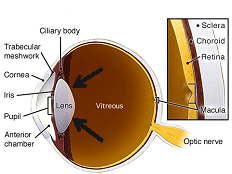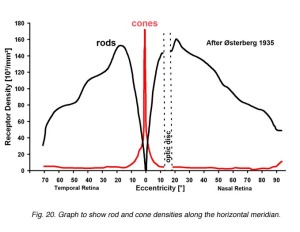As is often the case, most of the ideas for this blog come from actual questions asked by patients. On Eye to the Future today we will be answering one of these questions I received just last week, “How do animals see in the dark?”
GREAT QUESTION!
How exactly does my dog and cat run scot-free through a dark room but I stub my toes and step painfully on toys?
The answer: it’s all in the design of the eye.
Thanks for stopping by, next week on Eye to the Future we will be discussing… kidding of course.
To answer this question fully, there are actually three major anatomical differences between the human eye and animal eyes capable of great night vision.
Rods versus Cones
 As most are aware, the retina is the covering of the inside of the eyeball. Although this thin tissue is only about 3 human hairs thick, it is essentially the ‘film in the camera’ and is responsible for sensing the light that enters the eye and transmits that signal back to the brain where it is processed. The actual cells that sense the light are called photoreceptors and there are two main types: rods and cones. Although they both are important in seeing, they do so very, very differently.
As most are aware, the retina is the covering of the inside of the eyeball. Although this thin tissue is only about 3 human hairs thick, it is essentially the ‘film in the camera’ and is responsible for sensing the light that enters the eye and transmits that signal back to the brain where it is processed. The actual cells that sense the light are called photoreceptors and there are two main types: rods and cones. Although they both are important in seeing, they do so very, very differently.
Cones are responsible for color vision and high acuity vision however these cells only function in bright light. Rod cells, by contrast, are much less sensitive to colors and fine details but are able to detect light and function in much lower light situations.
In humans, 90% of our cones cells are located in the central part of our vision which allows us vivid, clear, and colorful central vision, but general poor vision under scotopic (dark) conditions because of a lack of rods in our central vision (graph at right).  By contrast, nocturnal animals have retinas composed mostly or even entirely of rods cells, especially in their central vision. This affords nocturnal animals great night vision; however, their lack of cone photoreceptors leaves these animals with little to no color vision and an overall decrease in clarity compared to humans.
By contrast, nocturnal animals have retinas composed mostly or even entirely of rods cells, especially in their central vision. This affords nocturnal animals great night vision; however, their lack of cone photoreceptors leaves these animals with little to no color vision and an overall decrease in clarity compared to humans.
Bigger is Better
Since nocturnal animals cannot benefit from the crisp vision that cone cells allow, they require a much larger image to focus on their retinas. The easiest way to accomplish this is with a larger eye and larger eye structures (like a stronger focusing cornea and lens as well as a larger pupil to let in more light). The human eye is about 24 mm (about 1 inch) in diameter. The eyes of nocturnal animals are substantially larger even through the animal itself can be much, much smaller. The owl is a perfect example of this since it has an eye that is about the size of a human eye but gives enough visual information to allow the owl to be a successful night bird of prey. However if we are talking size, the most dramatic example and clear winner of the “Biggest Eye on the Planet” award goes to the giant squid which is able to visualize prey in the pitch black of the ocean’s depths with an eye that’s the size of a dinner plate!!
Tapedum Lucidum
Although larger eyes and specialized retinal cells are certainly useful, nocturnal animals have one final trick up their sleeves to help with night vision. The retina in all animals is a clear, see through tissue. The reason for this is because the rod and cone cells that actually sense the light are at the back of the retina, so the layers above need to be clear to let light get through. Now in a human eye, once the light goes through the retina it hits the retinal pigmented epithelium or RPE. This thin layer of cells is highly pigmented and absorbs excess light that gets through the retina to reduce glare/scattered light and improve overall clarity of vision.
However, many nocturnal animals like deer, raccoons, cows, horses, and even dogs and cats, have developed a specialized RPE behind the retina called the Tapedum Lucidum that does the exact opposite. Instead of being highly pigmented to absorb the light that the retina does not collect, the Tapedum Lucidum is a highly reflective tissue, like a mirror, that actually bounces the light back through the retina for a second chance to be detected. This adaptation effectively doubles the chance that even very low amounts of light will be detected by the retina. Reflections off of this tin foil like Tapedum Lucidum is also what causes the brilliant white reflections from the eyes of nocturnal creatures, like a deer in headlights or even a photo of the family pet.
 We hope you have enjoyed this long answer to a short question. Next time on Eye to the Future, we will be discussing polarized lens. How they work, how they’re made, and why they are so, so useful for clarity and vision.
We hope you have enjoyed this long answer to a short question. Next time on Eye to the Future, we will be discussing polarized lens. How they work, how they’re made, and why they are so, so useful for clarity and vision.
I’ll leave you with a picture of our sweet boy, Remy, taking a rest from reeking havoc and showing off his Tapedum Lucidums.
See you next time on Eye to the Future.


